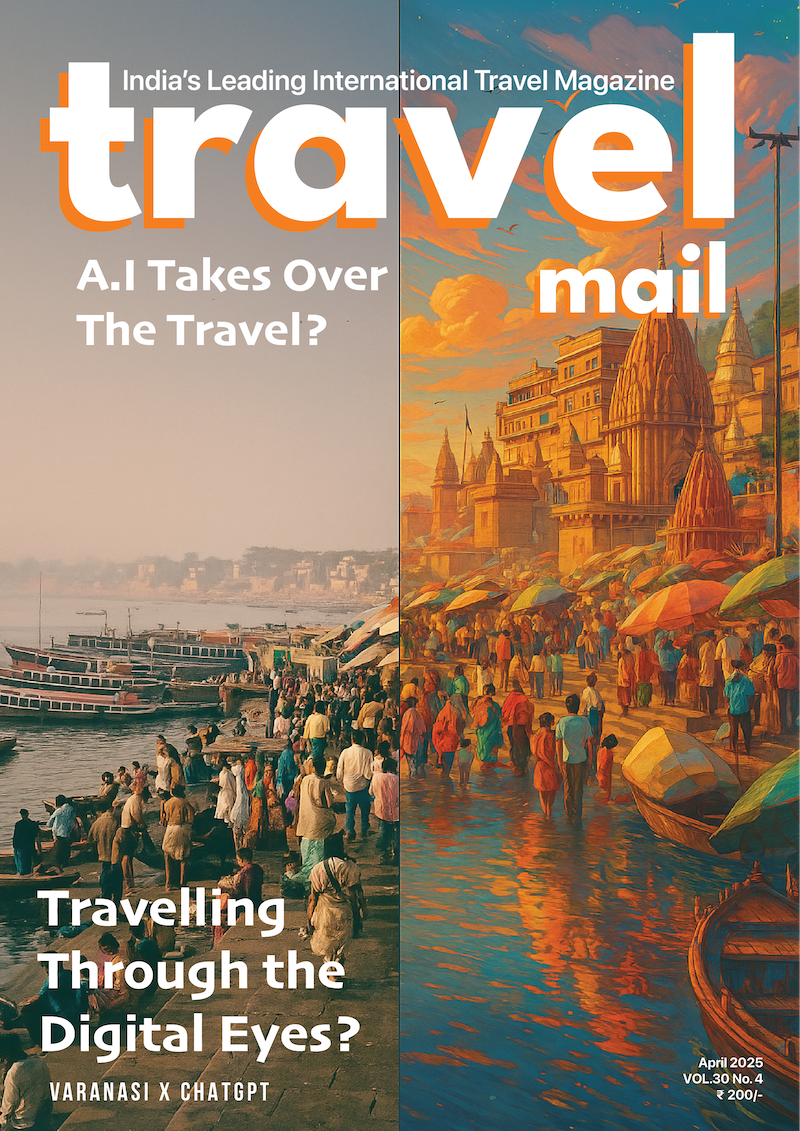Travel Mail Desk: The Ministry of Tourism’s Dekho Apna Desh Webinar series titled “Stories of Chennai” hosted on 07th November 2020 focused on Chennai which was one of the earliest settlements of the East India Company in India. Colorful temples, grand colonial buildings, bustling markets, classical music and dance – are many unique cultural encounters that a visitor can look forward to. Dekho Apna Desh Webinar series has been organised in the spirit of Ek Bharat Shreshtha Bharat to promote domestic tourism.
Presented by Mrs Akila Raman, a postgraduate in History and a collector of assorted historical and mythological stories and trivia, Akila has over fifteen years of teaching under her belt. She has also been a Language Trainer in the ITES industry for a short stint. Akila has a beautiful way with words, loves telling stories and is happiest when meeting new people. At Storytrails, she is a storyteller, a senior research associate and head of training.

The second presenter, Mr. Vijay Prabhat Kamalakara went to a B-School, and worked in the Banking and IT industries, before founding Storytrails in 2006. He loves puns, history, stage, trivia, and words in general and is grateful that his work surrounds him with people who obsess about these even more. Vijay is an avid traveler, a complete foodie and a marathon runner. Vijay is the recipient of the ‘Young creative entrepreneur award’ from the British Council and the ‘Youth achiever award for innovative entrepreneurship’ from Yuva Shakti.
The webinar started with an introduction to the most vibrant, electronic, IT hub and a cultural State Chennai formerly known as Madras, the official name until 1996 is the capital of the Indian state of Tamil Nadu. Chennai is famous for an assortment of things –silks, motor parts, gold, electronics and IT giants, among others. It is also a cultural hub, a social center, a temple city and the gateway to interior Tamil Nadu and Pondy. Located on the Coromandel Coast of the Bay of Bengal, it is one of the largest cultural, economic and educational centres of south India.
The name Chennai was derived from the name of a Telugu ruler, Damarla Mudirasa Chennappa Nayakudu, father of Damarla Venkatapathy Nayak, a Nayak ruler who served as a general under Venkata III of the Vijayanagar Empire from whom the British acquired the town in 1639. The name Madras is also of native origin, and has been shown to have been in use before the British established a presence in India.
A Vijayanagar-era inscription dated to the year 1367 that mentions the port of Mādarasanpattanam, along with other small ports on the east coast, was discovered in 2015 and it was theorised that the aforementioned port is the fishing port of Royapuram. According to some sources, Madras is derived from Madraspattinam, a fishing village north of Fort St George.
However, it is uncertain whether the name was in use before the arrival of Europeans. British military mapmakers believed Madras was originally Mundir-raj or Mundiraj, which was the name of a Telugu community, Mundiraj, who were the native inhabitants of the city.
There are also suggestions that it may have originated from the Portuguese phrase Mae de Deus or Madre de Dios, which means “mother of God”, due to Portuguese influence on the port city, specifically referring to a Church of St. Mary. In 1996, the Government of Tamil Nadu officially changed the name from Madras to Chennai.
The presenter further highlighted by taking us back in time to the year 1600, when a group of wealthy merchants and aristocrats got together and set up a joint stock company in London called the Honourable British East India Company to trade with India. Their first ships came to Surat, a small port near Bombay and soon they were in the area that is today called Madras.
They settled in a fortified area called St George’s fort, which was also called White Town. All the locals settled in nearby Black Town. The city as we know it today grew out of all the little settlements that came up around the Fort. As Madras grew, this Fort became the power center. In those days this was the seat of Government. And till date, this continues. This is still the seat of the Government, the Tamil Nadu legislature functions from here.
Storytrails also gave an account of how the French actually ruled Madras for three years, before the British got it back. And about the beautiful St. Mary’s Church, which is the oldest Anglican Church east of the Suez Canal. The first person to get married here was Governor Elihu Yale. He made lot of money illegally and became very rich in Madras. Later, he helped fund a new school, and today, that is the Yale University.
The Kapaleeshwara Temple is in Mylapore, an area which is older than colonial Madras. The ancient Greeks and the Romans were familiar with this port city. Marco Polo visited this place in 1292, and wrote about it. The next to arrive here were the Portuguese. They came in 1522 to trade, and settled by the coast. Their place became the white town. The locals were pushed inland, and lived in what came to be known as the black town. And then the British got here in the 17th century.
Their industrial revolution had started and they were frantically searching for raw material, especially cotton. They soon ended up with their own piece of land. And it was from this that the city of Madras grew. Very soon Mylapore became a part of Madras, the first city that the British established in India. ·
Mylapore is famous for the kapaleeshwara temple that stands proud there. This temple is dedicated to Lord Siva, the god of destruction. His temple is definitely worth visiting. Visitors are welcome inside and it is very interesting to see all the customs and rituals played out as a part of everyday life inside the temple. It is a bustling place, filled with locals going about their business with their god. The enormous temple tank, the colourful flower sellers and the narrow lanes around the temple offer a lot of interesting sights, and even more pictures. And right nearby is the Santhome Church, where an apostle of Christ, St Thomas is buried.
Next story was about Kalakshetra, the famous dance school in Chennai. The storytellers told us about the indomitable Rukmini Devi Arundale, and how she worked to improve the status of Bharathnatyam. Rukmini had enough financial clout to purchase land and set up a school on the outskirts of Chennai to exclusively further Bharathnatyam. That school is called Kalakshetra and it is still considered one of most sought after places to learn Bharathnatyam..
Ice house, now called Vivekanandar Illam, was another fascinating story. It was about an enterprising young American named Fredric Tudor, who decided to bring ice to Madras. He was successful, and to store the ice, special ice houses were built in Calcutta, Bombay and Madras. These buildings were specially designed to store ice – they were circular, double-walled, windowless structures.
Only one of these three buildings survives the Madras ice house. Today, this building is a museum, showcasing the life and teachings of Vivekananda, who stayed here for a short time. And what used to be the Madras Ice House is now called Vivekanandar Illam or the Vivekananda House.
Last story was about the Amaravathi Marbles in the Egmore Museum in Chennai, the second oldest museum in India, after Calcutta. These stones were carved between the 2nd century BCE and the 3rd century CE. They are some of the earliest examples of Buddhist art in the world. This Amaravathi style of carving is the oldest style of Buddhist art. Most of these sculptures were carved in white limestone and depict Buddhist fables or scenes from Buddha’s life.
The concluding part of the webinar was about the delicious food in Chennai which not only consist of idly, dosa, vada , sambhar and Chutnies but also varieties of chicken, fish and chettinad food. The presenter also shared the celebration of Deepavali in Chennai which is celebrated early in the morning by taking oil bath, wearing new clothes and preparation of wide varieties of sweets and savouries.
Summing up the webinar Rupinder Brar , Additional Director General spoke about the Incredible India Tourist Facilitator Certification (IITFC) Programme, a digital initiative of Ministry of Tourism (MoT), Govt. of India for the citizens of India. It is an online programme where one can learn about tourism at their own time, space, path and pace. The successful completion of this programme would enable the learner to become a Certified Tourist Facilitator of Ministry of Tourism, Govt. of India and can proudly become story teller and a host to the tourist visiting India.
The Dekho Apna Desh Webinar Series is presented in technical partnership with National e Governance Department, Ministry of Electronics and Information Technology. The Sessions of Webinar are now available on the https://www.youtube.com/channel/UCbzIbBmMvtvH7d6Zo_ZEHDA/featured and also on all social media Handles of Ministry of Tourism, Government of India
Read more Stories at TravelMail | Follow us at Facebook | Twitter | Instagram for on the go news


